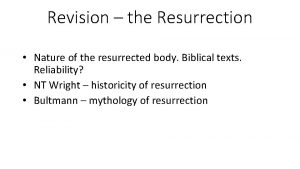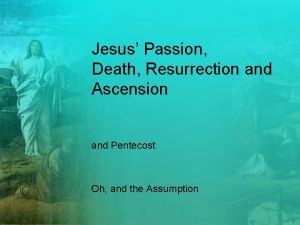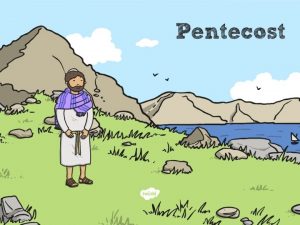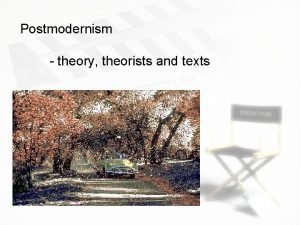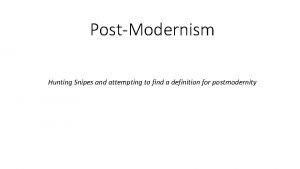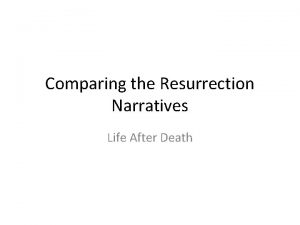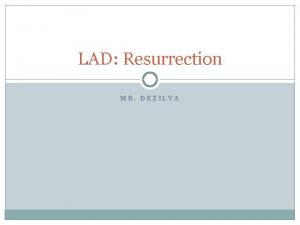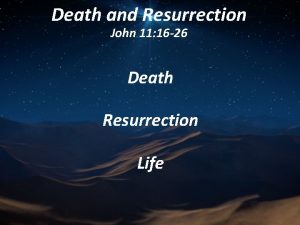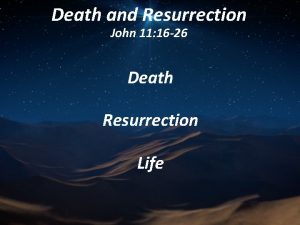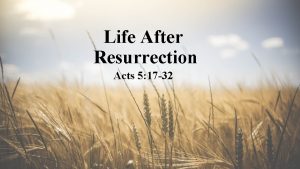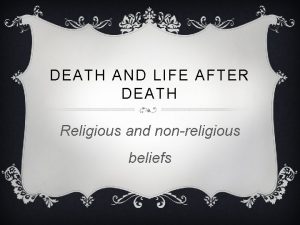Comparing the Resurrection Narratives Life After Death At














- Slides: 14

Comparing the Resurrection Narratives Life After Death

• At this point, the direct comparisons end. • This is because a quick scan at the Greek shows that Mark's Gospel has ended, and that an ending has been tacked onto the end by the Early Church (which appears to comprise a summary of the appearances related in the other Gospels)

Mk’s Resurrection • The Marcan Resurrection Narrative ends at verse 8: – There are linguistic and stylistic differences in the Greek; – Verses 9 -20 do not appear in the oldest manuscripts. • Mk’s Gospel, for some reason, is unfinished: – Mark might have died before completing it, possibly in the persecution of Christians carried out by Nero in the wake of the fire in Rome in the 60 s AD. – The original ending of the Gospel might have been lost, for many reasons, before it was copied.

Mk’s Resurrection • Mark intended to complete his gospel at verse 8. The 'unfinished' feel is no mistake: – if the ending of one copy of the gospel was lost, why was it not completed from another copy; – if it was the original copy that was unfinished for whatever reason, why did not the author, or one of his colleagues, complete it; – the bad grammar at the end of the last verse echoes the bad grammar all the way through the Gospel.

Mt’s Resurrection The Power of God • Matthew's use of apocalyptic imagery associated with the resurrection starts in Mt 27, during the crucifixion narrative: • the earthquake; • the raising of bodies of the saints which later appear in Jerusalem; – all confirm that God has intervened in a decisive way in human history, through the Passion and Resurrection of Jesus Christ. • The eschatological imagery continues in Ch. 28: • the removal of the stone door of the tomb by an angel from heaven; • the terror of the guards, and the women. – All serves to underline the sovereign power of the God who has planned this from the beginning and proclaimed it through His prophets.

Mt’s Resurrection Insistence on a physical resurrection in the face of opposition • Indication of local dispute with synagogue. These Jewish Christians were concerned to demonstrate the physical nature of the resurrection - the only type of resurrection a Jew would understand. • The rumour that the disciples stole the body demonstrates two things: – That the body of Jesus really disappeared from its burial place. ; – That for whatever reason, no-one produced it afterwards to dispel the rumour of the Resurrection. No mucking about with 'spiritual' resurrections, or with the 'conviction of the continuing presence of Jesus in spirit with His disciples here. '

Lk’s Resurrection The Nature of the Resurrection • Luke's presentation appears to be unambiguous at first sight. The risen Jesus impacts the physical world. He can walk, talk, enter houses, pick up objects, tear bread, eat. • The Risen Christ explicitly denies that he is a ghost, or any form of disembodied spirit, inviting His disciples to touch His flesh and bone, as though to reassure them of His physical reality.

Lk’s Resurrection • Yet the body with which He is provided has some, shall we say, unusual properties. He walks for several hours beside a married couple, two of His followers, talking to them, without their recognising Him. • He can enter locked rooms without using the door, and appears to defy the laws of gravity, ascending into the sky, where his disciples finally lose sight of Him in a cloud. • So is this 'body' physical or spiritual - real or unreal?

Lk’s Resurrection: Caird • The answer is to be found in 1 Cor 15 where the 'spiritual' body is discussed. • Caird suggests that the word 'spiritual' used by Paul does not mean non-corporeal, insubstantial, but instead refers to a changed substance, a reality that requires a physical body for its development as its seed, in the way that a plant develops from its seed.

Lk’s Resurrection: Caird • The body of the Risen Jesus has qualities that can be identified as real in the sense of being physical (it occupies space, can impact upon its surroundings etc) but with qualities that transcend those normally associated with the physical. • The non-recognition of Cleopas and his wife of Jesus is explained by their not expecting to see him, and only recognising Him in the familiar action of giving thanks over the food.

Lk’s Resurrection: Borg • 1 Cor 15 is 'a chapter that strongly suggests that the resurrection body is not a physical body. ' • He invites the reader to consider whether a video camera would have caught Jesus walking with Cleopas and his wife, talking with them, going into their house. • He has already made clear his difficulty believing that they could have spent so much time talking with their beloved Master without recognising Him, the sudden recognition over the blessing, and Jesus' disappearance.

Lk’s Resurrection: Borg • The conclusion we are to draw, he suggests, is clear. • “I do not see the Emmaus Road story as reporting a particular event on a particular day, visible to anybody who happened to be there, but as a story about how the risen Christ comes to his followers again and again. ”

Jn’s Resurrection • Of course, we know that the events happened early on the Sunday morning, but we could have known that for the 4 th Evangelist, it would have to be 'dark'. • Jesus' followers have not yet understood that the Resurrection must happen to fulfil the Scriptures. They have not yet encountered the Risen Jesus, and their understanding is darkened. • Also, light symbolises the presence of Jesus, the day, when, He says, He can work.

Jn’s Resurrection • It is John's Gospel that most clearly emphasises the interest that the Father has in each person, and the necessity for each individual to respond to Jesus. • Mrs Greer-Spencer…
 What is the nature of the resurrection narratives
What is the nature of the resurrection narratives Jesus' passion and death
Jesus' passion and death Day of pentecost 50 days after
Day of pentecost 50 days after After me after me after me
After me after me after me If any man come after me
If any man come after me What do muslims believe about life after death
What do muslims believe about life after death Postmodernism media examples
Postmodernism media examples Postmodernism definition
Postmodernism definition The purpose of the narrative text is …
The purpose of the narrative text is … What are narratives
What are narratives Oral narratives
Oral narratives Conclusion story
Conclusion story Narrative tense
Narrative tense Primeval narratives
Primeval narratives What is a literacy narrative example
What is a literacy narrative example
